In the 1960s, women's chiffon scarves were more than just accessories; they were symbols of elegance and personal expression. The lightweight fabric draped beautifully, allowing for versatile styling that complemented both casual and formal looks. You'd spot bold floral patterns from designers like Vera Neumann and geometric designs that captured the mod aesthetic. Each scarf, often hand-rolled for quality, showcased exquisite craftsmanship. Prices varied, making them accessible yet collectible. These scarves reflected the decade's cultural revolution, effortlessly blending fashion with individuality. If you continue exploring, you'll uncover more about the significance and evolution of these iconic pieces.
Historical Context of Chiffon Scarves
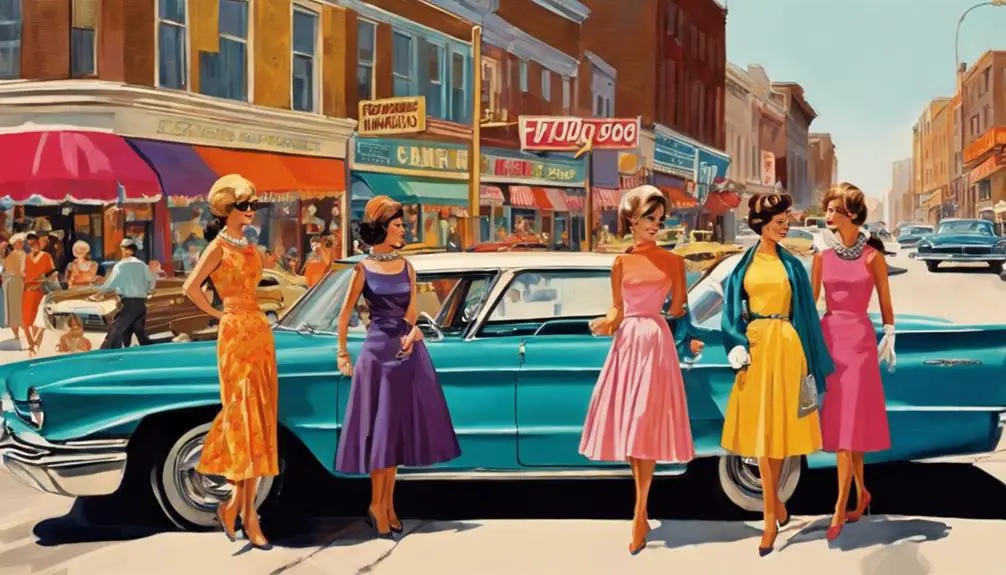
In the vibrant tapestry of the 1960s fashion scene, chiffon scarves emerged as a symbol of the era's dynamic cultural shifts. During this fashion revolution, bold colors and striking prints reflected the spirit of change sweeping through society. Designers like Vera Neumann played a pivotal role in popularizing chiffon scarves, creating distinctive pieces adorned with floral prints and geometric patterns that resonated with the youth's desire for self-expression. Vintage clothing labels from this era often reveal the craftsmanship and unique designs that made these accessories so iconic, showcasing the intricate stitching and fabric types typical of the time, such as those from vintage clothing labels.
The lightweight and sheer quality of chiffon made these scarves incredibly versatile. You could effortlessly layer them, tying them around your neck or wearing them as headscarves, allowing you to showcase your individuality. As the decade progressed, these accessories became essential staples, highlighting the vibrant, eclectic aesthetics that defined 1960s style.
Fast forward to today, and the rise of vintage fashion has sparked renewed interest in these iconic chiffon scarves. Collectors now seek out original pieces, driving up demand and resale values. The artistic influences of pop art and mod styles further underscore the significance of chiffon scarves as emblematic of a transformative era, making them not just accessories, but cherished artifacts of fashion history.
Iconic Designs and Patterns
Chiffon scarves of the 1960s stand out for their enchanting designs and vibrant patterns that captured the essence of the decade's cultural shifts. The era was a canvas of creativity, reflected in the bold, colorful motifs adorning these accessories. Floral patterns, like those popularized by Vera Neumann, featured playful elements such as ladybug accents, embodying the whimsical spirit of the time.
You'd notice that geometric patterns also gained traction, appealing to the mod aesthetic that defined this vibrant decade. The scarves served as a perfect accessory for those embracing the bohemian lifestyle, showcasing eclectic prints and themes that ranged from paisley to Hawaiian motifs. This variety not only highlighted individual expression but also echoed the growing global influences on fashion.
Many vintage chiffon scarves from this period featured hand-rolled edges, a demonstration of the craftsmanship that elevated their status among collectors and fashion enthusiasts. As you explore the iconic designs of 1960s scarves, you'll discover how these colorful patterns not only completed outfits but also told stories of a dynamic era marked by artistic exploration and cultural exchange.
Material and Craftsmanship Insights
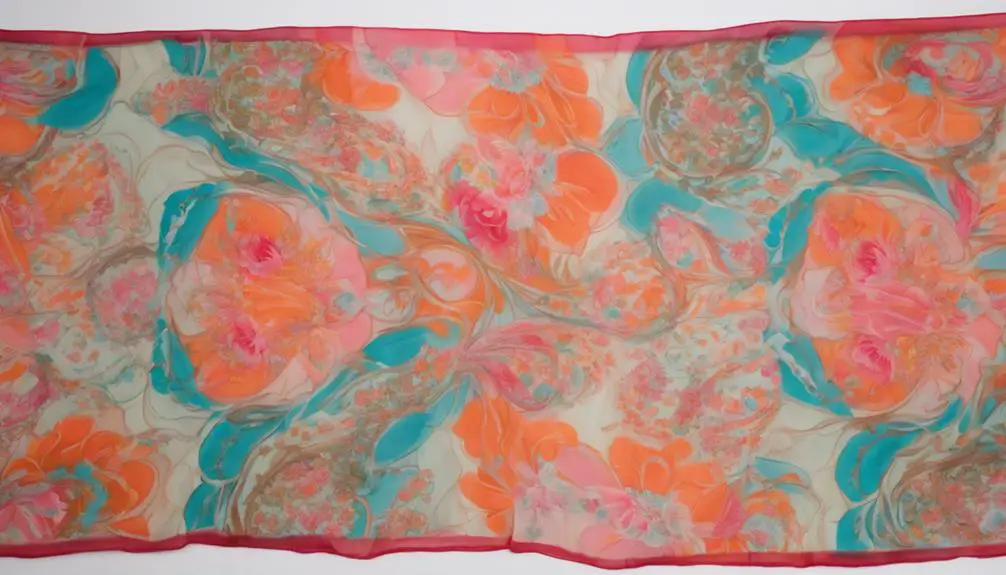
While exploring the allure of 1960s scarves, you'll find that their lightweight materials—often a blend of silk, nylon, and rayon—contributed greatly to their delicate, airy feel. Chiffon, in particular, was a favored choice for its ethereal quality, allowing these scarves to drape beautifully. The craftsmanship in these pieces is remarkable; many featured hand-rolled edges, showcasing the level of detail and skill involved in their creation. Vintage clothing labels from this era often reflect the quality and style of these accessories, such as those from Betty Barclay, which became popular for its stylish designs during the mid-20th century.
The artistic styles of the era influenced the unique patterns and vibrant colors on these scarves, with bold geometric designs that captured the spirit of the 1960s. This marriage of quality materials and distinctive designs not only enhances their vintage appeal but also makes them highly collectible today.
To maintain the integrity of these delicate fabrics, careful maintenance was advised—hand washing and air drying were essential to preserve the vibrant colors and soft textures. By understanding the material and craftsmanship behind 1960s chiffon scarves, you can appreciate the artistry and attention to detail that defined this iconic accessory, making it a timeless addition to any wardrobe.
Pricing Trends and Market Demand
The vintage market for chiffon scarves from the 1960s reflects a growing appreciation for unique accessories that embody both style and history. Currently, you'll find prices for vintage chiffon scarves ranging from $6.75 to $86.94, with the average hovering around $20.00 for common styles. This pricing trend is driven by an increasing market demand for statement fashion pieces, particularly among collectors and fashion enthusiasts who seek out items that tell a story. Understanding the historical context of labels can greatly enhance the value of these scarves, as provenance plays an essential role in their desirability.
Scarves designed by notable figures like Vera Neumann often fetch higher prices, with listings between $24.00 and $130.00, influenced by the design and condition. The thriving market for these vintage scarves indicates a considerable interest in 1960s fashion, as these items are not only trendy but also desirable to many.
Additionally, many sellers provide "best offer" options, promoting negotiation and potentially lower prices for savvy buyers. This dynamic environment allows you to engage actively in the vintage fashion scene, making it an exciting time to explore and invest in these unique accessories. As the market continues to flourish, the value of vintage chiffon scarves is likely to rise, strengthening their place in contemporary fashion.
Styling Tips and Versatility
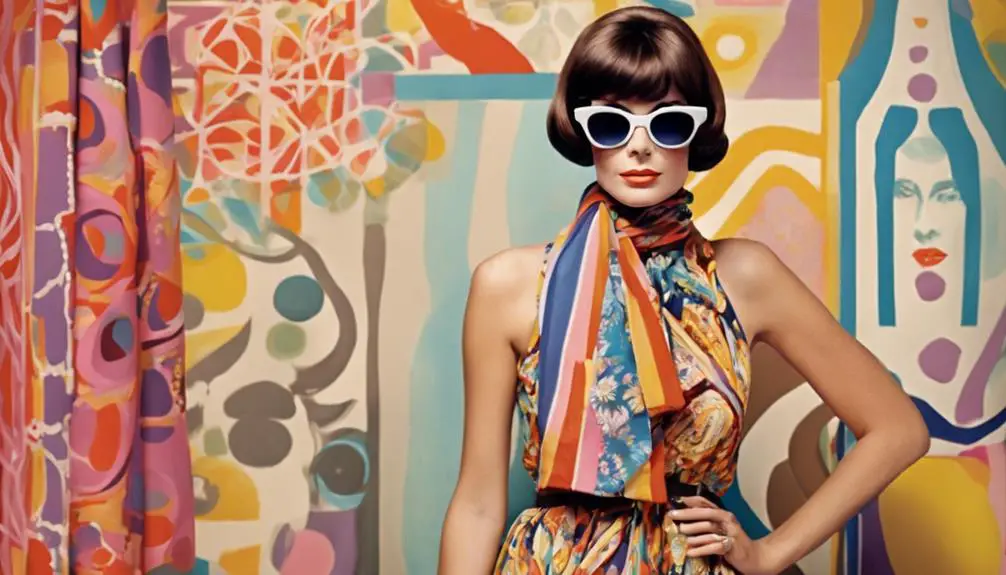
Numerous styling options exist for vintage chiffon scarves from the 1960s, making them a truly versatile accessory. Their lightweight and sheer texture allows you to layer them seamlessly, enhancing both casual and formal outfits. Here are some effective styling tips to make the most of these versatile statement pieces:
- Headscarves: Tie a chiffon scarf around your head for a chic retro look, perfect for a day out or a picnic.
- Neck Wraps: Drape it around your neck, tying it in a knot or bow to add elegance to any outfit, whether it's a sundress or a tailored blouse.
- Hair Accessories: Wrap it around a ponytail or bun to introduce a pop of color and pattern, especially with floral designs that scream 1960s fashion.
- Belt Alternative: Use a scarf as a belt by threading it through belt loops for an unexpected twist.
Many vintage chiffon scarves feature hand-rolled edges, enhancing their quality and adding a sophisticated touch. With creative tying techniques, you'll discover endless possibilities for accessorizing outfits while celebrating the vibrant spirit of the 1960s.
Notable Brands and Collections
Vintage chiffon scarves from the 1960s not only showcase versatile styling options but also embody the distinct flair of notable brands that defined the era. Among these, Vera Neumann stands out with her vibrant floral designs and high-quality craftsmanship, creating scarves that often featured exquisite hand-rolled edges. Collectors particularly seek out signed Vera scarves, which are prized for their rarity and connection to vintage fashion.
Another significant player was Burmel, known for its unique color combinations that catered to the bold fashion trends of the time. Burmel's designs added a distinctive touch to the wardrobes of fashionable women, enhancing their outfits with striking patterns. Echo vintage scarves, including a notable fuchsia piece owned by Ann Klein, reflected the eclectic artistic styles that defined 1960s fashion.
Luxury brand Jean-Louis Scherrer also made waves with chiffon shawls priced at $39.00, appealing to those seeking elegant yet timeless pieces. The combination of these brands and their innovative designs contributed to the rich tapestry of vintage fashion, making their chiffon scarves not just accessories, but coveted collectibles in today's market.
Frequently Asked Questions
How Were Scarves Worn in the 60s?
In the 60s, you'd tie scarves around your hair or neck, creating chic looks. You could drape them over your shoulders or add flair to handbags, showcasing vibrant patterns that reflected your personal style and femininity.
How Do You Wear a 60S Scarf?
You can wear a 60s scarf by tying it around your neck or head, creating various knots and bows. Drape it over your shoulders for a chic shawl effect or incorporate it into your hairstyle.
How Do You Wear a Chiffon Scarf?
To wear a chiffon scarf, you can style it around your neck, tie it in your hair, or drape it over your shoulders. Experiment with various knots to showcase patterns and enhance your outfit's appeal.
What Decade Were Scarves Popular?
Scarves gained immense popularity in the 1960s, reflecting the decade's vibrant fashion trends. You'll find that their bold patterns and versatility made them essential accessories, influencing styles and showcasing individuality in a rapidly changing cultural landscape.
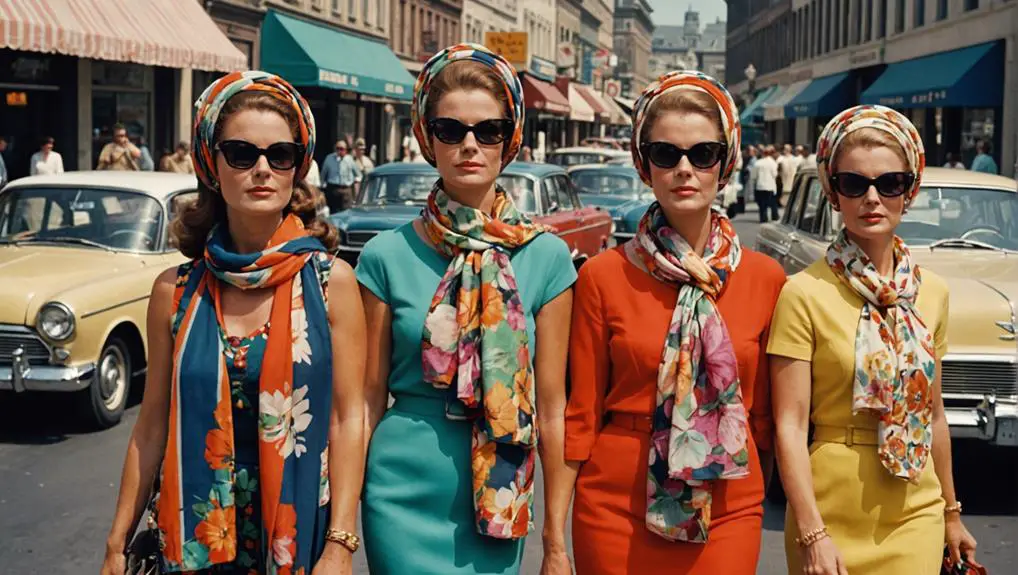

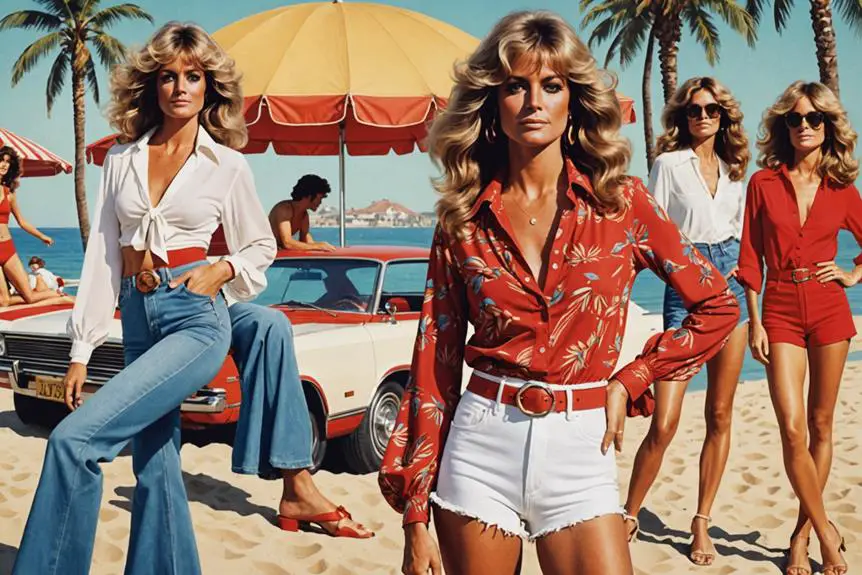
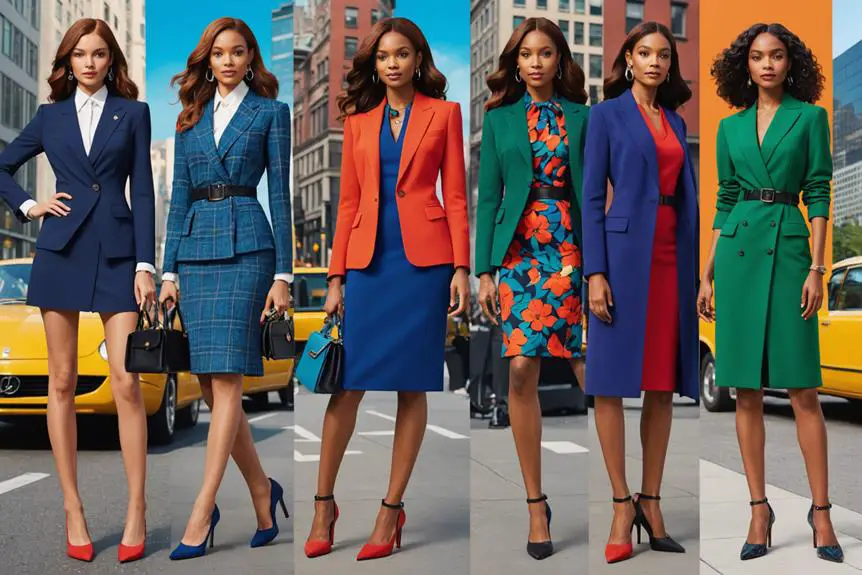
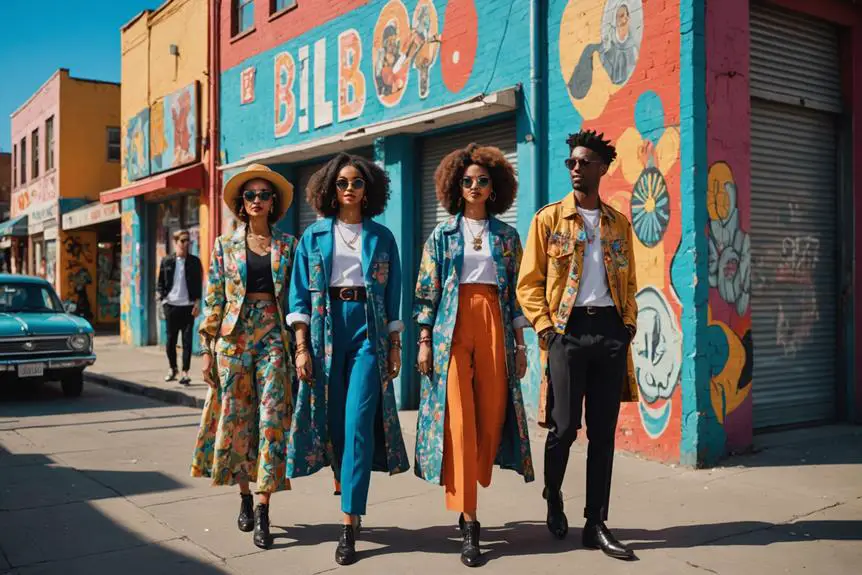
One Comment